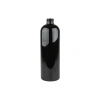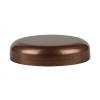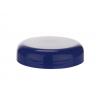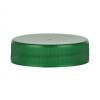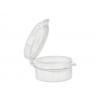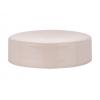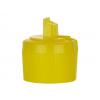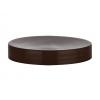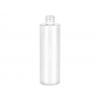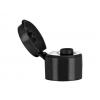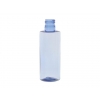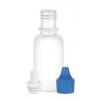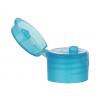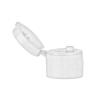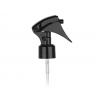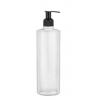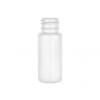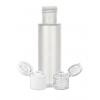Please check out the packaging guides below. There will be more to come soon! In the meantime, if you have a question, please call us at 1-866-436-6373.
- Guide to Finding the Correct Cap Size "Finish"
- Types of Liners (Seals)
- Plastic Packaging Recycling Codes and Typical Plastic Properties
Guide to Finding the Correct Cap Size "Finish"
Choosing the correct closure or "cap" is a very important step of the packaging process. Plastic and metal closures come in a variety of sizes, styles and colors.
In the packaging industry the word "finish"is used to refer to the material surrounding the neck opening of any container or the inside dimensions of a cap. You'll often see finish sizes written in a format such as 24/410 or 24-410. There are two important parts to this number: the first number, 24, refers to the diameter in millimeters. The second part refers to the thread count. Below, we'll explain how to get these measurements.
The first number you need to find is the diameter. This measurement must be in millimeters (mm).
For a bottle: Measure from the outer edge of the thread on one side to the outer edge of the thread on the opposite side. For example, if the neck measures 24mm, then know it requires a 24mm closure.

For a cap: Measure from the inside wall of the cap to the opposite inside wall.

The second number refers to the thread count. If the thread loops around the neck and passes over itself one time, this is considered a 400 finish. If the thread passes over itself one and a half times, it's considered a 410 finish. If a thread passes over itself 2 times, it's a 415 finish. These are just a few of the most common thread counts.
 |
 |
 |
|
400 Continuous Thread |
410 Continuous Thread |
415 Continuous Thread |
We highly recommend testing your products with packaging samples to determine proper compatibility. If you need further help please contact our friendly staff.
Measuring Cards
Ask your Sales Rep to send you our FREE measuring card with your samples!
Types of Liners (Seals)
|
L.L. - LINERLESS |
A closure that has been engineered to function in specific application without the use of an additional liner. |
|
UNLINED OR NO LINER |
A closure with no special sealing features and no liner. |
|
F-217 (TRI-SEAL) |
A foamed low-density polyethylene core between two solid layers of LDPE. |
|
PS - PS-22 |
Pressure-sensitive adhesive, coated on polystyrene foam. |
|
P.V. - PULP/VINYL |
Vinyl laminated to pulp board. |
|
P/VAF |
Pulp and vinyl coated aluminum foil. |
|
SA-66 |
Polyester film laminated to aluminum foil bonded to pulp board. |
|
P/PE |
Polyethylene-coated white paper laminated to pulp board. |
|
PW |
Pulp board with wax coating on one side. |
|
CONE LINER |
Cone-shaped solid polyethylene. |
|
P/RVTLF OR PVLF |
Vinyl coating applied to HDPE - coated white paper laminated to pulp board with lubricant film over vinyl. |
|
PE |
Solid extruded polyethylene. |
|
P/AF |
Aluminum foil laminated to paper and bonded to pulp board. |
|
P/AFPET |
Polyester film applied to aluminum foil, poly bonded to paper and laminated to pulp board. |
|
P/O |
Pulp and oilpaper. |
|
P/SF |
Pulp and Saran Film. |
|
P/SOLVSEAL |
Laminated pulp board. |
|
P/TEFLON |
Teflon on pulp board. |
|
PW |
Pulp board with a wax coating on one side. |
|
P/WPW |
White paper laminated to pulp board with a wax coating on the white paper. |
|
PLASTISOL |
Vinyl chloride resin applied as a liquid and baked to a final form. |
|
P/TF |
Tin foil laminated to paper and bonded to pulp board. |
|
14B WHITE RUBBER |
White vulcanized styrene-butadine rubber. |
|
F1410 |
Teflon/silicone rubber/polypropylene film. |
|
HS (HEAT SEAL) |
Induction sealing is a no contact heating process that accomplishes the hermetic sealing of a container with a closure that includes a heat-sealable foil laminate. The typical induction innerseal begins as a multi-laminate liner inside a closure. It consists of a polymer that is compatible with the bottle material and capable of heat-sealing to the lip of the container when the closure is placed onto the container and is passed through a heat source - usually an electromagnetic field produced by an induction heater. |
Plastic Packaging Recycling Codes and Typical Plastic Properties
|
Polyethylene |
High Density |
Polyvinyl |
Low Density |
Polypropylene |
Polystyrene |
Other |
|
|
Properties |
 |
 |
 |
 |
 |
 |
 |
|
Clarity |
Clear |
Translucent |
Clear |
Translucent |
Translucent |
Clear |
Plastic ID Code "7" is for other plastics |
|
Moisture |
Fair to Good |
Good to Excellent |
Fair |
Good |
Good to Excellent |
Poor to Fair |
|
|
Oxygen Barrier |
Good |
Poor |
Good |
Poor |
Poor |
Fair |
|
|
Max Temp |
120F |
145F |
140F |
120F |
165F |
150F |
|
|
Rigidity |
Moderate to High |
Moderate |
Moderate to High |
Low |
Moderate to High |
Moderate to High |
|
|
Resistance to Impact |
Good to Excellent |
Good to Excellent |
Fair to Good |
Excellent |
Poor to Good |
Poor to Good |
|
|
Resistance to Heat |
Poor to Fair |
Good |
Poor to Fair |
Fair |
Good |
Fair |
|
|
Resistance to Cold |
Good |
Excellent |
Fair |
Excellent |
Poor to Fair |
Poor |
|
|
Resistance to Sunlight |
Good |
Fair |
Poor to Good |
Fair |
Fair |
Poor to Fair |


